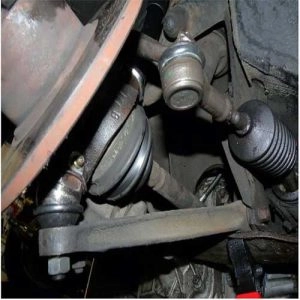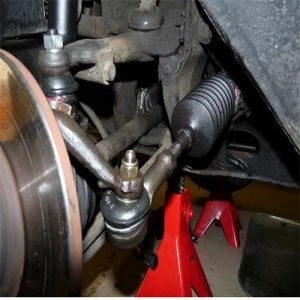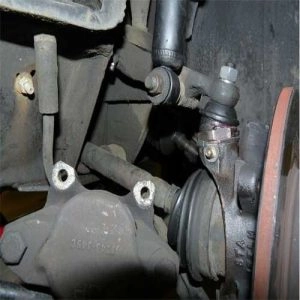In this article, we will discuss one of the essential parts of a car that is indispensable, the car's joint. We'll explain its notable characteristics, the most common causes and signs of its damage, and some other related information.
What is the knee in a car?

The car's ball joint, or suspension joint, is a component that forms an important part of most modern vehicles. These ball joints function like a joint, allowing the car's suspension components to move up and down, as well as allowing full rotation from one side to another (i.e., to the extent of 360 degrees). They are located between the control arms and the steering knuckle and are a pivotal component between the car's suspension system and the wheels.
As for its design, it is usually spherical and located inside a cavity filled with grease, covered by a rubber cap that helps prevent dirt from entering. Some of them may contain a grease nipple useful for adding lubricant, while others have sealed designs. Typically, there are four, two lower pairs and two upper pairs that connect the suspension to the front axle of the car. Care should be taken to avoid a car's knee joint from breaking to prevent catastrophic damage, as its breaking would completely free the tire, which could lead to the damage of that tire, or the car's fender, or even several other components of the car's suspension.
Reasons for Damage to the Ball Joint

There are many reasons that can lead to the failure of a car's joint. One of those reasons is the wear and tear of the rubber cover, which allows the entrance and accumulation of dirt and dust within the joint. Besides, the joint of the car may get damaged due to the leakage of the lubricating substance in which the joint operates. Rust and wear can also damage the joint. Of course, we should not forget that a ball joint is ultimately a mechanical part with a lifecycle. Over time, with increased movement, it loses its stability and begins to deteriorate.
How do I know if the car's joint is damaged?

This question has occupied a large space on the internet due to the many people that ask it and search for a comprehensive answer to it. Therefore, we decided in this section to alleviate the burden of those people, and introduce them to the main 4 signs indicating damage to the car's knee. If you, dear reader, are also looking for the same thing, continue reading this article until you get what you need. These signs are:
Lack of steering wheel stability
One prominent sign indicating a problem with the car's suspension is that the steering wheel will generally stay straight if the suspension is in good shape and the car's balance is good. However, if the car's suspension is damaged, you will notice the steering wheel veering to the right or left.
Uneven wear of the front tires.
There are many reasons for uneven wear on the front tires of a car. One of those reasons is damage to the car's joint, as this damage will either lead to the inner edges of the front tires wearing down, or to the wearing of their outer edges. The wear will appear on either the inner or outer tread, not on both. As for the other causes of tire wear, they might be due to poor wheel balancing, or an imbalance in the car's alignment. Therefore, everyone should take care of their car tires and check them carefully.
Also read:4 symptoms indicating an air sensor failure.
Grease Leakage
If you find grease leaking from your car's ball joint cover, this leakage may be a clear indication of the start of ball joint damage. This leakage usually occurs due to cracks in the rubber cover, which typically appear after prolonged use. If you neglect this issue and leave it unresolved, the problem will escalate. Eventually, the scissor nut will be completely damaged due to the ingress and accumulation of dirt inside.
Clicking noises from the front suspension.
This sign serves as a warning of the onset of damage to the ball joint, as the clicking noises emitted by the car's front suspension are due to wear in the ball joint of the knee. As a result of this wear, the knee becomes loose in the cavity and begins to make clicking sounds. If it is not replaced promptly, it may break at any time.
Therefore, if you encounter any of the previous symptoms, you should consult a specialized technician or visit a inspection and maintenance center to check the car's joint and replace it if it's damaged. This is because it's difficult for you to inspect the joint yourself, due to its complex location that's hard to reach without sufficient experience.
When should the car's joint be changed?
The axle is constantly in use every time the car is driven, and with frequent use, it begins to deteriorate. It is especially prone to damage when driving on rough roads. Generally, it is estimated that the lifespan of the CV joint ends after traveling a distance of about 240,000 kilometers, at which point it should be replaced. However, it might become susceptible to...The car's kneeThis depends on your driving, prior to any damage occurring.

Comments